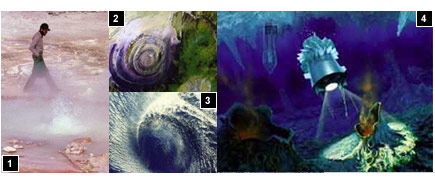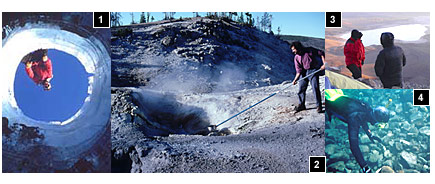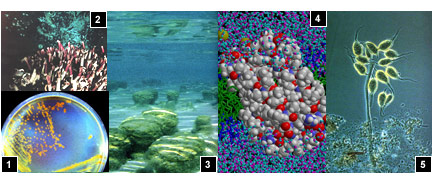 |
If Microbes begat Mind
This workshop series on the creative process in science looks at how
scientists and cross-disciplinary teams tackle ultra hard problems on
the frontiers of science, showing the role that design thinking plays
in their process. We zoom in on intertwined grand challenges, where finding
clues in one domain can offer clues in others:
- what artificial life simulations reveal,
- synthesizing a living cell,
- debating how the origin of life on Earth occurred,
- hypotheses about the evolution of mind, and
- exploring how design enables scientific discovery and technology
innovation.
These workshops explore how scientists apply design methods to come up
with hypotheses for hard problems. Extending debates and questions raised
in Zann Gill’s book, If Microbes begat Mind, DV records of these brainstorming
sessions allow us to see how design thinking enables cross-disciplinary
problem-solving. Better understanding of the dynamics of discovery and
innovation aims to improve support for cross-disciplinary teams.
| |
From
Games to Apps:
Artificial Life
Challenges |
|
 |
| |
|
past event — University of Indiana
Bloomington,
Indiana
|
|
|
|
At the ALife X conference a lively international
group with scientists from the UK to Italy, from Spain
to New Zealand, debate what ALife can contribute to science
and technology, brainstorming concepts for competitions.
The driving questions:
- What, in your opinion, are three key unanswered questions
that ALife may someday answer?
- What significant challenges/ competitions would you
propose where ALife models could make a unique contribution
toward answering these questions (or relevant sub-questions)?
- For ultra hard questions, what benchmarks would you
propose — significant achievements enroute to the “golden
fleece”?
- How do you think competitions/ challenges in each of
these domains should be structured?
- What do you see as the most important implications
of your proposed challenge for science and technology?
Competition challenges proposed: Evolving a Robot Brain,
controller for a robot to accomplish defined tasks, combating
evolution of drug resistance by viral or bacterial agents
(e.g. HIV), and “The Evolution Prize.”
The DV record captured in the June 4 session, and subsequent
interviews with key players, is the first step toward developing
a DVD to observe cross-disciplinary design brainstorming
on this topic. We’ll select from among the ideas that surface
the most promising to develop when we turn this raw material
into a DV segment, working with Mark Bedau, Editor-in-Chief
of Artificial Life (M.I.T. Press Journal) on an associated
written publication. |
|
 |
| |
Design Challenges Harnessing C-IQ:collaborative intelligence, emergence & complexity
|
|
 |
| |
|
past event — International Conference on Complex Systems
Marriott Boston Quincy, Boston, MA, USA
Discussion of ways to harness C-IQ to conceive and support design challenges. Competitions are Petri dishes to culture and study C-IQ, harnessing “empty constructs” that enable implicit ideas to emerge and become explicit as convergent process tracking observes the collaborative dynamics. Collaborative intelligence embeds emergent principles into interactive frameworks for decision support, e.g. collaborative intelligence prompters, recommender systems, and semantic meta-tagging.
> C-IQ
WIKI
|
|
|
|
 |
|
 |
| |
Searching
for
Extremophiles, the Limits
of Life |
|
From abandoned mines to Yellowstone geysers,
from dives deep sea vents to theorists using their computers
to study complexity and information theory, the theory
of limits is honed by scientists in search of the limits
of life.

1. Yellowstone
National Park: terrestrial analog studies,
such as this search for extremophiles. 2. “Ox-eye”:
the famous landmark for astronauts in the Mauritanian
desert caused by sediment from primeval ocean
being pushed up to the Earth’s surface. 3. Blanca:
tropical storm. 4. A
mission to a deep ocean vent.
|
The term “extremophiles” is the name given to the organisms
(mostly bacteria and archaea) living in places that are
physically and chemically extreme (from our human perspective).
Their habitats include boiling mud of geothermal hot springs,
super-heated waters of submarine hydrothermal vents, frozen
soils of Siberia, sea-ice of the arctic, extremely high
pressures at the bottom of the deepest parts of the oceans,
and a variety of places where the local chemistry would
be instantly toxic to human beings. Extremophiles are adapted
to these habitats, and would die in habitats that we find
hospitable.

1. Chris
McKay at an ice hole, Antarctica. 2. Jonathan
Trent on an Astrobiology expedition
to Kamchatka, Siberia. Inside the Mutnovski caldera. 3. Nathalie
Cabrol at the summit of the volcano
Licanbur in the Bolivian Andes, where an astrobiology
team did field work, finding extremophiles at
Laguna Verde (the highest lake in the world). 4. Underwater
diving training at Lassen (2500 m).
|
Extremophiles known as thermophiles live in hot springs
(>50°C); they are metabolically “frozen” when they are
cooled to what we consider a comfortable temperature. Extremophiles
known as psychrophiles grow at temperatures below 20°C
and are able to grow at 0°C; they are “cooked” at our body
temperature (37°C). Extremophiles known as piezophiles
or barophiles live at the bottom of the deepest parts of
the ocean at >1,000 atmospheres pressure. They die rapidly
when decompressed to one atmosphere. Extremophiles known
as halophiles live in waters saturated with salts. They
burst in fresh water. Acidophiles thrive in concentrated
acid (pH 0.5) and are destroyed at neutral pH. Other extremophiles
are specifically adapted to live in areas with high levels
of radiation, concentrated toxic chemicals, a paucity of
nutrients, or a scarcity of water. Taken together, extremophiles
represent the ingenuity and versatility of evolution to
exploit energy sources and adapt to harsh conditions.
Our knowledge of extremophiles on Earth continues to expand
as we explore more remote and seemingly inhospitable environments
using advanced technologies. Molecular probes have revealed
that conventional microbiological methods provide us with
information about <1% of the diversity of organisms
in most habitats; i.e. over 99% of the organisms have yet
to be described and characterized. Molecular techniques
and advances in microscopy and sampling procedures provide
tools to discover the more extreme extremophiles and to
understand the molecular basis of their existence. In return,
extremophiles provide macromolecules and inspiration to
address fundamental questions in biology, biotechnology,
and nanotechnology, such as
- What are the physical and chemical limits of life on
Earth?
- What molecular adaptations allow living systems to
inhabit extreme environments?
Extremophiles have inspired scientists from conceiving new
drugs for the pharmaceutical industry to developing new ways
to address environmental pollution. How can we apply what
we learn from extremophiles to important problems in biotechnology,
nanotechnology, and planetary protection? |
|
 |
| |
Unraveling
clues to
The Origin of Life |
|
The Origin of Life is a Rosetta Stone, requiring
translation and integration of findings in a range scientific
disciplines and demonstrating the role design methods play
when scientists tackle hard, cross-disciplinary problems.
A range of theorists have examined the origin of life
from different perspectives: from Jack Szostak, whose lab
at Harvard studies the synthesis of precursors of a living
cell, to Stuart Kauffman, theoretical biologist and complexity
theorist, to Graham Cairns-Smith (clay theory of the origin
of life) and Peter Ward and Donald Brownlee (“The Rare
Earth Hypothesis”). Perplexing questions drive our search
for clues to the origin of life:
- Was life a chance event or a foregone conclusion? Is
the fine-tuning that favors life on Earth a coincidence
or a clue?
- Did life’s rules govern its origin? Did life invent
its rules? Or both?
- Did life start, and evolve, solely by random mutation
and environmental selection? Or were other principles
at work?
- Beyond the extremes of Darwinian Blind Chance and Intelligent
Design, is there a “third option”?

1. Origins
of life and limits of life studies overlap,
since the extremes of life provide evidence of
how life might have endured space travel or originated
in the extreme conditions on early Earth. Extremophile
bacteria Deinococcus radiodurans (D. rad) can
survive extreme levels of radiation, dehydration,
extreme temperatures, and exposure to genotoxic
chemicals. 2. Tubeworms in
the the boiling water of thermal vents are home
to bacteria, which thrive at these temperatures
and may provide clues to the origin of life. 3. Stromatolites survive
as our earliest fossil record of life on early
Earth some 3.8 billion years ago. 4. Simulations
of cellular proteins M2 protein in a
membrane. Through simulation experiments, Andrew
Pohorille’s group studies membrane behavior. 5. The
Fruiting Body is one of the most primitive
examples of collaboration; one-celled organisms
are attracted to form a community, which generates
this fruiting body.
|
Astrobiology integrates many disciplines and so is an
ideal testbed for cross-disciplinary scientific and engineering
collaboration. Geologists study how the Earth evolved and
when it might have had the constituents for life. Paleontologists
examine the fossil record. Chemists form hypotheses about
what kind of chemistry might have made the leap from non-life
to life and how that process might have occurred. Astronomers
seek other planetary systems where life might exist.
Biologists look at replication and metabolism in biological
systems and imagine what their precursors might have been.
Computer scientists construct simulations to see what emerges
from artificial evolution in the ecosystems they build.
Physicists wonder if the key to life's origin lies in the
physics of far-from-equilibrium systems, or in that pervasive
force that played a key role in forming our universe -
gravity. Newer sciences, such as information theory and
complexity theory, explore the origin of life from their
theoretical perspectives, harnessing tools like cellular
automata and artificial life. And this only samples the
surface. |
|
^ top
|
 |